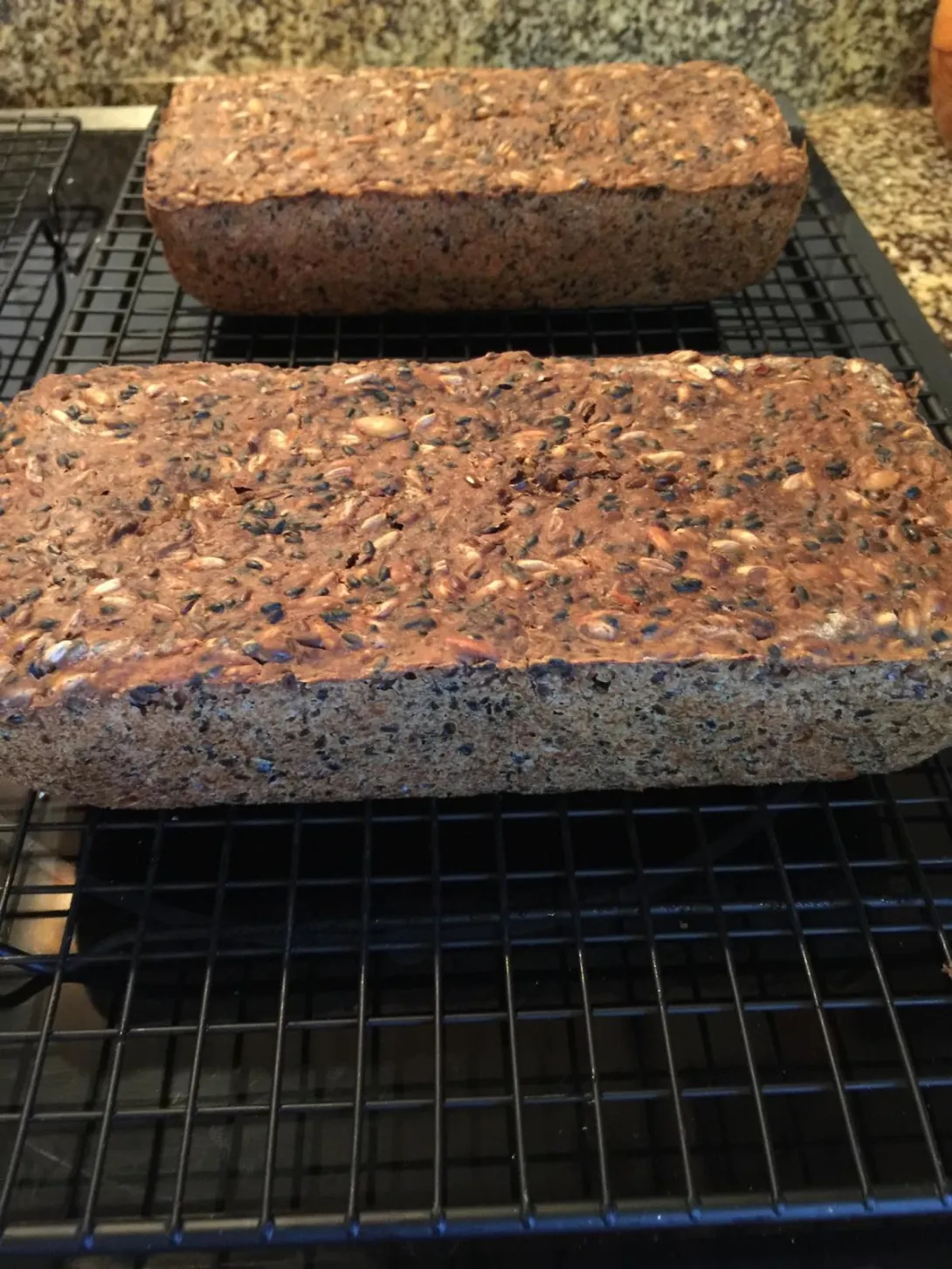
Well, I am not too sure what to think of this bread. It feels a bit like I baked four bricks.
I followed the recipe exactly as written in Tartine 3 except for the baking part where I gradually reduced the baking temperature and covered the loaves for the first part of the bake as per DAB and Cedar Mountain. Oh and I lightly toasted the seeds.
They are now wrapped up in parchment, foil and plastic wrap. I am letting them sit till tomorrow where I will have a taste. Hopefully they taste fine as some are going to the soup kitchen as well.
Interesting to note that the loaves had 0 rise in the fridge and 0 rise in the oven. They did rise some before I put them in the fridge so my next attempt will be to let the loaves rise to the top before putting them in the fridge.
I will also need to get 2 regular metal loaf pans so that I can get a higher loaf. These were baked in smaller loaf pans and I filled 3 of them about 3/4 full and the last had only enough dough for half full so these are pretty slim.
That half full loaf is going to be kept for grating into my version of Rene's Meta Loaf which is anothe recipe in Tartine 3. I think I will use the quantities and the ingredients of one of my other recipes but sub out the seeds for the grated bread.
- Danni3ll3's Blog
- Log in or register to post comments
Some Rye breads are dense. So what's the verdict?
It is very dense and I can really taste the toasted seeds and the sourdough tang in it. It goes great with some pate. Slicing it thin is the key otherwise it would be way too chewy.
it is properly proofed and ready for the oven and having the oven up to temperature at the same time. A high percent rye bread is easy to make and pan up but the worst to know when it is proofed! It seems each recipe is different when it comes to proofing. Usually, if you don't over bake it and wrap it to let the remaining moisture re-distribute it may come out more dense than it should but still slice and be fine to eat - and you can't beat the taste - if you like rye bread.
Some people think that you shouldn't retard a high percent rye but the cold really slows down the amylase enzyme action that destroys the crumb and I have never had a problem doing it. What really helped me was PiPs telling me to sprinkle rye flour in the top of the loaves and when it cracked it was ready for the oven. The flour makes it easier to see the cracks. Some people, ike Mini Oven, look for little pinholes, but my eyesight isn't that good nor am I as good a rye baker as she is.
I think the last rye we made in mid September when the kitchen was still very warm it sat in the pan for 5 hours, no retard, was sprouted too but had lots if goodies added in the crumb - and a 30% prefermented flour levain. It also sat on the counter for another 3 hours for bulk ferment before panning - so 8 hours from start to finish. If I had retarded it, you would have to add maybe even more than 3 hours to the 8 before it would have been ready.
I think your loaves came out beautimous for a first attempt. Patience comes to those who wait a long, long time!
Well done and happy baking Danni.
It is encouraging to know that I am on the right track. Here is the coveted crumb shot.
Makes me want to try a seeded rye bread bake. Looks like it would be excellent with lox, pickled herring or sharp cheese.
Well done! I am inspired to do a loaf.
Happy baking! Ski
Do you happen to remember whether you took the loaves, after the last rise, directly from refrigerator to oven, or did you let them sit at room temperature for a bit before baking? The recipe doesn't call for letting the loaves return to room temp before baking, but I wonder if that was an omission. Thank you!
But I am sure I baked them straight out of the fridge without any room temperature time.
Hey Danni - hope you're good! I have two pans of this in the oven right now. It's a first attempt at this recipe. I'm going to try and dial in a dense seeded nordic rye loaf this winter and decided to start that journey with this recipe. When I loaded the dough into my regular non-stick pans they were pretty much full. I left them on the counter for two hours and they've risen beyond the peak so hopefully they wont rise any more than that overnight in the fridge. I ended up buttering (salted) the inside of shower caps on each to help with non-stick by morning as they've risen beyond the lid pan - no idea if that will work but it was my best guess at what to do. I should have split this into three pans. But here's my question - you said something about wrapping the bread in parchment, (aluminum?) foil and plastic wrap.. what's that all about? If it's for moisture redistribution why not just plastic wrap? Not sure what the parchment or foil are there for? And you let them sit like that for a day after baking? If you remember - let me know please. Many thanks! frank!
I think I did wrap them like that for moisture distribution and as well to freeze them. I guess plain plastic wrap would do as well. Let me know how yours turn out.
thanks!